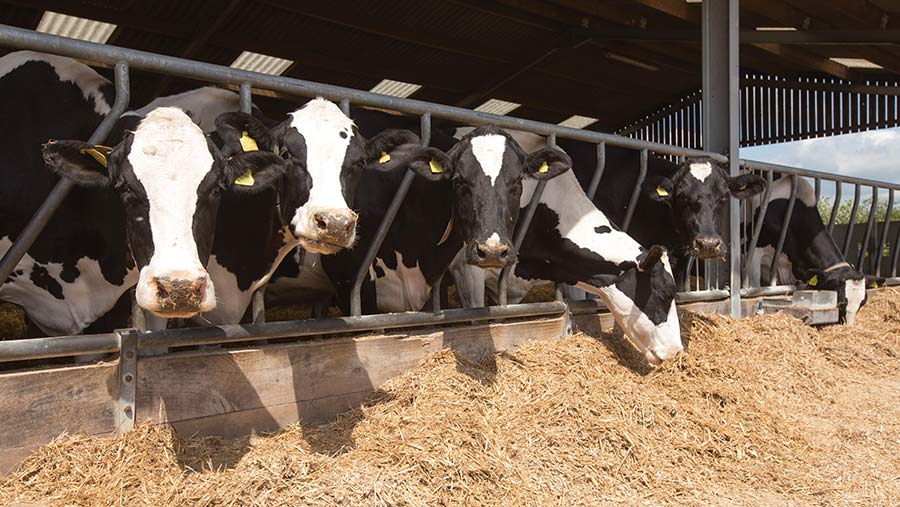5 ways to improve udder health with dry period management
 © Tim Scrivener
© Tim Scrivener The dry period is crucial for udder health and provides an opportunity to cure chronic infections.
However, it also presents some unique challenges that may increase the risk of new infections.
Measuring mastitis and somatic cell count (SCC) performance in fresh cows allows us to monitor the success of the dry period.
Aim for:
- Less than 8% of cows with a clinical mastitis case in the first 30 days of lactation
- More than 90% sub-clinical “prevention rate” – in other words, less than 10% of cows calving with a high SCC (over 200,000 cells/ml) after finishing the previous lactation with a low SCC (under 200,000 cells/ml)
- More than 80% sub-clinical “cure rate”, which means less than 20% of cows calving with a high SCC after finishing the previous lactation with a high SCC.
See also: 5 expert tips on dairy transition management
If not achieving these goals, a complete check of dry period management is advisable. This involves looking at the following areas:
1. Cow condition
Some dry period problems come from stale cows not being in optimum condition for drying off. Issues include:
- Excessive body condition – this increases the risk of transition diseases, including mastitis
- Review fertility, nutrition, and management procedures such as timing of drying-off, to help reduce the number of fat, stale cows.
- High milk yield at drying-off – this is associated with increased risk of udder infection
- Look at feeding strategies in the final weeks of milking to try to reduce yield at drying-off
- Reduced milking frequency can also help suppress yield, but this can introduce other udder health risks, so needs to be approached carefully
- A high prevalence of udder infections in lactation, which increases the number of cows needing to be cured over the dry period
- If more than 30% of the herd is drying off with a high SCC, review risk areas for lactation-origin infection.
2. Calcium metabolism
Low calcium levels at calving are not just a problem for downer-cow syndrome: hypocalcaemia (clinical and sub-clinical) is also a risk for udder infections in fresh cows.
- A high incidence of milk fever (more than 3%) implies a lot of sub-clinical cases too, although herds can struggle with high sub-clinical rates even when not experiencing clinical cases
- Blood-testing is a cheap and easy way to check your herd’s calcium status. Discuss a monitoring programme with your routine vet
- Preventative measures tend to be more productive than “sticking plaster” treatments. These include:
- Reviewing supplementation of magnesium with your vet
- Discussing partial or full dietary cation-anion difference (DCAD) rations with your nutritionist
- Consider allocating pasture that does not receive additional potash to make silage for dry cows.
3. Trace element status
Dairy cows tend to be well supplemented in essential minerals through lactation, via concentrate feed or mixed rations.
However, trace element provision is often less consistent through the dry period, leading to deficiencies as cows reach calving.
Low levels of minerals such as selenium and iodine can all increase mastitis risk.
- Ensure dry cow rations contain appropriate levels of key trace elements
- If concerned, discuss blood-testing a sample of fresh cows with your vet
4. Selective dry cow therapy (SDCT)
Targeting antibiotics use for cows likely to be infected is becoming the norm within the UK dairy industry.
But protocols for selecting cows for treatment with antibiotics at drying-off can be inappropriate, leading to poorer udder health.
- All cows should receive internal teat sealant
- Individual cow SCC recording is essential for implementing SDCT
- Check your current herd situation is suitable for SDCT
- Problems such as widespread Staphylococcus aureus infections should be controlled before using a selective approach
- Adjust selection criteria to fit your herd’s risk profile
- The higher the bulk tank SCC, the lower the individual cow SCC should be to reduce the risk of infected quarters being missed
- Use additional criteria to increase the safety margin when not using antibiotics
- Yield should be less than 20 litres at drying-off
- Cows with teat-end hyperkeratosis may not be suitable for sealant-only treatment
- Clinical mastitis history should be taken in to account.

© Kathy Horniblow
5. Check the environment is suitable
Higher bacterial challenges during the dry period increase the risk of mastitis. Minimising exposure to bacteria is an extensive topic, but some key points are commonly forgotten.
- When calving cows in the same yard as the transition group, remember to adjust the stocking rate
- Calving cows need approximately 150% of the space of a dry cow
- When calculating loose yard capacity, subtract high-traffic zones from the total available area
- For example, gateways onto the bedding area generally reduce capacity by one cow space
- Shield water points from the bedding, so splashing does not reduce the dry bed area.
- Avoid using permanent calving paddocks without rotation
- Use similar maximum grazing periods and minimum resting periods to those recommended for milking cow grazing
- Maintain pasture with minimal potash supplementation to help avoid calcium imbalances.
See more Dairy Titbits articles

